Labour market report, January 2018
Employment in 澳门永利 declined in January. Get the details in this report.
Quick facts
In January 2018, there were 11.8 million people in 澳门永利 aged 15 years or older, 7.6 million, or (64%), were either working or actively looking for work. Of this population, 7.2 million, or 61%, were employed and 82% of them had a full time job.
澳门永利鈥檚 unemployment rate was 5.5%, with 420,600 unemployed people.
Employment declined in January
Employment in 澳门永利 declined by 50,900 net jobs in January, following an increase of 6,100 new jobs in December.
January鈥檚 job losses were the most recorded in 澳门永利 since January 2009 (95,700).
Chart 1 shows employment in 澳门永利 from January 2013 to January 2018
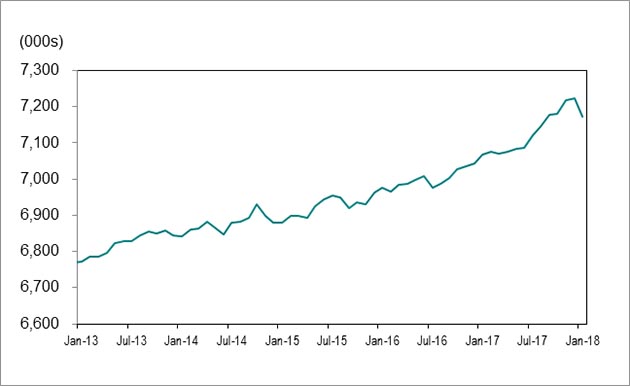
Source: Statistics Canada, Labour Force Survey, Table 282-0087, (seasonally adjusted data).
Full-time vs. part-time
There was a loss in part-time jobs (59,300) in January. Full-time jobs increased by 8,500.
Employment increase/decrease by age
Youth employment (those aged 15 to 24) declined by 25,800 jobs in January, following a decline of 4,600 jobs in December.
People ages 25 to 54 saw an increase in employment of 5,600 in January compared to December. Those aged 55 and older lost 30,600 jobs.
Employment in Canada declined by 88,000 in January, following an increase of 64,800 jobs in December.
Unemployment rate declined to 5.5%
Chart 2 shows unemployment rates, 澳门永利 and Canada, January 2013 to January 2018.
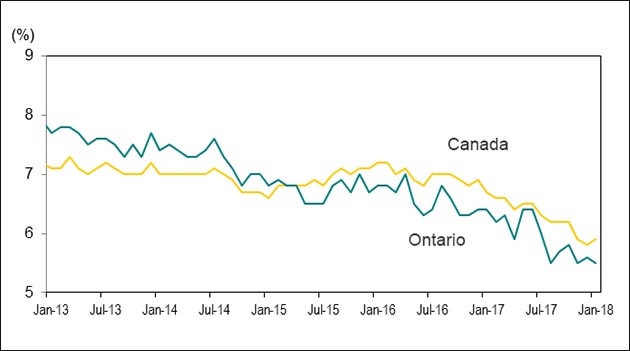
Source: Statistics Canada, Labour Force Survey, Table 282-0087, (seasonally adjusted data).
澳门永利鈥檚 unemployment rate declined to 5.5% in January from 5.6% in December, matching November as the lowest unemployment rate since July 2000 (5.4%).
Canada鈥檚 unemployment rate increased to 5.9% in January from 5.8% in December.
Unemployment rate by age
The unemployment rate for people aged 15 to 24 increased to 11.2% in January from 11.1% in December.
The unemployment rates for people ages 25 to 54 decreased to 4.6% in January from 4.7% in December, while it increased from 4.3% to 4.5% for those 55 and older.
Lowest and highest unemployment rates
Chart 3 shows Census Metropolitan Areas (CMAs) with highest and lowest unemployment rates in Canada, January 2018.
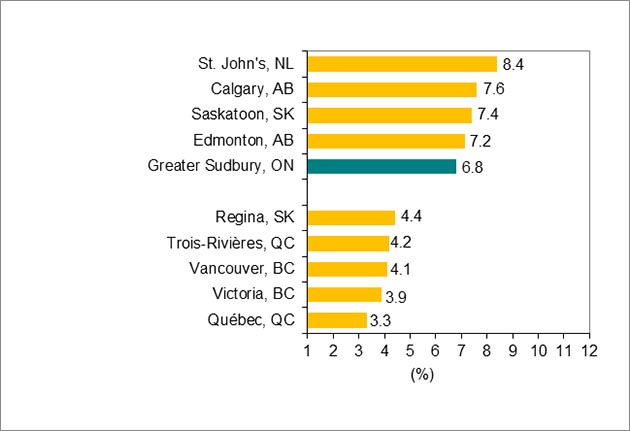
Source: Statistics Canada, Labour Force Survey, Table 282-0135, (seasonally adjusted data to reduce volatility caused by small sample size).
蚕耻茅产别肠 City (3.3%) recorded the lowest unemployment rate in Canada in January, while St. John鈥檚, Newfoundland (8.4%) recorded the highest rate.
Greater Sudbury had the highest unemployment rate in 澳门永利 (6.8%) in January. Peterborough and Windsor recorded the lowest rate, at 4.6%.
Year-over-year comparisons
In January 2018, employment in 澳门永利 increased by an estimated 72,100 jobs for adults 25 years and older compared to January 2017.
Employment increase and decrease by education level
Chart 4 shows 澳门永利 employment change by highest level of education attained, aged 25 and older, January 2017 to January 2018.
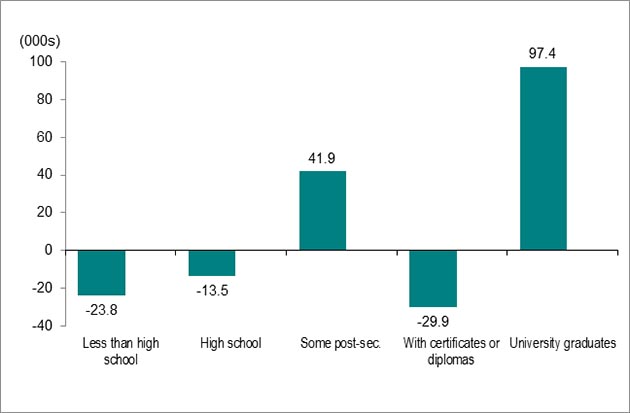
Source: Statistics Canada, Labour Force Survey, Table 282-0003, unadjusted data.
Adults with a university degree led gains, with 97,400 net new jobs.
Individuals with some postsecondary education (PSE) recorded job gains of 41,900, while employment for those with certificates or diplomas decreased by 29,900.
People with less than high school education and those with high school education recorded job losses of 23,800 and 13,500, respectively.
Unemployment rate by education level
The unemployment rate for adults aged 25 and older with PSE credentials was 4.0% in January 2018, down from 4.4% in January 2017.
The unemployment rate for adults without PSE credentials was 6.7%, down from 6.8% a year earlier.
Employment increase and decrease by occupation
Chart 5 shows 澳门永利 employment change by occupation, January 2017 to January 2018.
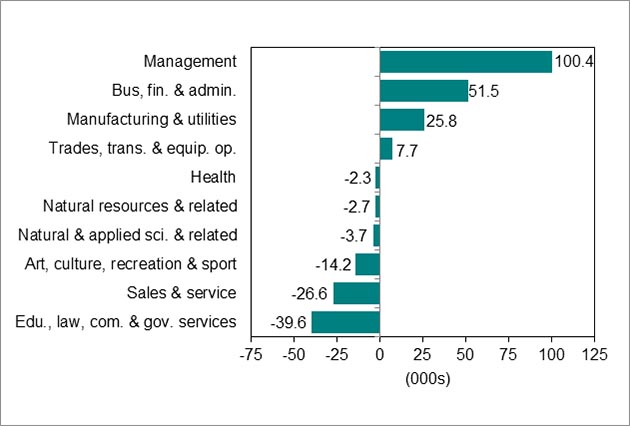
Source: Statistics Canada, Labour Force Survey, Table 282-0041, unadjusted data.
Six of the ten major occupational groups in 澳门永利 recorded employment losses in January 2018 compared to a year ago, despite overall year-over-year job gains.
Learn more about system.
These occupations lost the most jobs:
- education, law and social, community and government services (39,600)
- sales and service (26,600)
- art, culture, recreation and sport (14,200)
These occupations gained the most jobs:
- management (100,400)
- business, finance and administration (51,500)
- manufacturing and utilities (25,800)
Long-term unemployment decreased
Chart 6 shows 澳门永利鈥檚 long-term unemployed (27 weeks or more) as a percentage of total unemployment, January 2010 to January 2018.
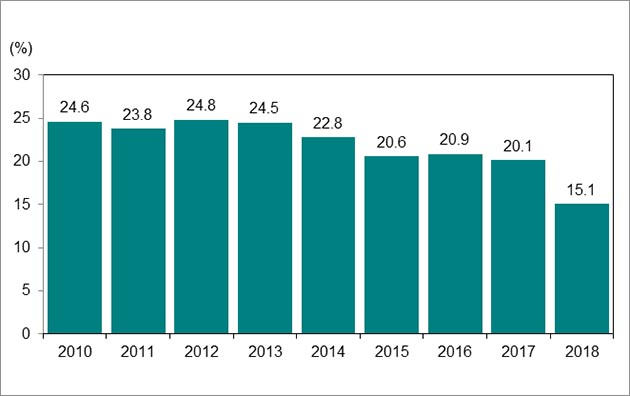
Source: Statistics Canada, Labour Force Survey, Table 282-0047, unadjusted data.
In January 2018, an estimated 64,100 people were long-term unemployed, or unemployed for 27 weeks or longer. This was down from 97,700 in January 2017.
Long-term unemployed individuals accounted for 15.1% of the total number of unemployed people in January 2018. This compared with 20.1% a year ago.
The percentage of long-term unemployed individual is still relatively elevated compared to pre-recession level in January 2008 when 11.7% of all unemployed people were long-term unemployed.
Average time in long-term unemployment
The average time in unemployment decreased to 18.1 weeks in January 2018 from 19.3 weeks in January 2017.
Download data
Source: Statistics Canada, Labour Force Survey
January 2018 Labour Market Report:
- CSV, , 1Kb
- CSV, , 2Kb
- CSV, , 2Kb
- CSV, , 99Kb
- CSV, , 12Kb
- CSV, , 15Kb